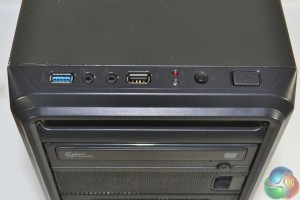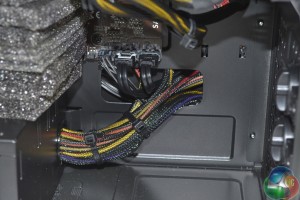Continuing the process of offering high value, cost effective components for the Diablo Reactor, Wired2Fire chooses to house the system inside a Raijintek Arcadia mid-tower chassis.
Raijintek has released a number of well-priced products that have provided solid bang for the buck in the cooling and chassis market segments. The Arcadia seems to follow that trend by offering a good amount of expansion and solid build quality for a current OCUK retail price of under £25.
The system's front does not diverge much past the chassis mesh and badge, however Wired2Fire does include a TSST DVD-RW (which will only add a few pounds to the retail cost). Raijintek cuts costs of the case by employing a large amount of plastic, although segments of the innards rely upon steel for structural rigidity.
There is no fan in the front slot of the case by default, and Wired2Fire chooses not to populate the position. Adding a 120mm intake fan would help to reduce GPU temperatures, so I think this is an area where Wired2Fire should have invested the extra £5 or so in upgraded cooling.
Indicative of its budget pricing, the Raijintek Arcadia front IO consists of one USB 3.0 port and one USB 2.0 port, headphone and microphone jacks, power and reset buttons, and operation LEDs.
The single USB 3.0 connector may actually suffice for gamers as they are less likely to be transferring large amounts of data on a regular basis (as, for example, content creators would).
The first noticeable point regarding the Wired2Fire Diablo Reactor's internal area is that a decent job has been done for cable management. While the case may not have a side panel window, Wired2Fire has tucked away many of the cables in order to optimise airflow. Let's not kid ourselves and say that this is the best cable management result that we have seen, but a good job has been done with a budget chassis and non-modular PSU.
As far as component aesthetics go, that is not one of the primary aims for the Wired2Fire Diablo Reactor. The general colour coordination is decent, excluding the contrasting CPU cooler and DVD drive's back end.
A mid-range Raijintek Themis Direct Contact CPU cooler (that retails for £19.99 on OCUK) is used to tame the 4.4GHz Devil's Canyon Core i5 CPU. Wired2Fire applies 1.22V to the CPU VCore which, thanks to the improvements brought out by Intel's Devil's Canyon refresh, is relatively easily handled by the modest cooler. Asus' Z97-P motherboard has no problem handling the clock speeds, either.
A pair of 8GB Corsair XMS3 DDR3 DIMMs provide 16GB of system memory operating at 1600MHz CL11. While CL11 is a loose setting for 1600MHz DDR3, it is unlikely to make a significant difference in games. The low profile XMS3 heatspreaders minimise interference issues.
Many people may be quick to question more than 8GB of memory in a gaming system. With recent titles like GTA V gobbling up RAM, as well as the need for extra resources to game-streamers, I think that 16GB is quickly become the new ‘go-to‘ capacity for gaming machines.
Providing the pixel-pushing power is a 4GB (or 3.5GB of fast VRAM, if you prefer) Nvidia GTX 970 manufactured by Palit and equipped with a ‘reference' blower-style plastic shroud. We have reviewed many GTX 970 models from board partners including Palit, however a variant of the card sporting a blower-style plastic shroud has yet to pass through our labs.
The blower coolers are typically preferable for multi-GPU systems because they vent most of the hot air out of the chassis. They do, however, typically operate with higher temperatures and noise levels in single-card operation.
There's no need for me to reiterate what is already known – despite the controversy/confusion over its VRAM design, the GTX 970 is a fantastic GPU that offers alluring frame rate performance with modest power draw. You can read our dedicated review of a Palit GTX 970 here.
The 600W FSP power supply (model number FSP600-50ARN) uses a single 12V rail design that is able to output a maximum current of 42A, translating into a power delivery of 504W on the 12V rail. Despite not flaunting a badge on the housing, the unit is rated as 80 Plus Silver efficiency.
Many people are quick to berate the use of a non-modular PSU, and that's fair enough in a personal system building environment. Personally, I do not see a huge problem with system building companies using a non-modular unit as it is their workers who are expending the extra cable management efforts.
Understandably, user-led upgrades are made more complicated from a cable management perspective, however initial purchase costs are certainly reduced by using a non-modular unit.
Wired2Fire opts to use Crucial's BX100 250GB SSD. The low-cost drive has a solid reputation for reliability. The Windows 8.1 OS and some initial programs are installed on the SSD, although there is enough space for a handful of games.
Higher capacity storage needs are handled by a 1TB Seagate Barracuda 7200.14 HDD.
Rear cable management is not the tidiest we have seen although Wired2Fire's efforts ensure that the leads do not block airflow.
Wired2Fire smartly covers the motherboard video ports and instructs users to opt for ports on the graphics card instead.
Four USB 3.0 ports are found on the rear IO panel. Only three audio jacks are featured on the motherboard and there is no optical audio output. This could be an issue for users aiming to connect to a home theatre surround sound system.
 KitGuru KitGuru.net – Tech News | Hardware News | Hardware Reviews | IOS | Mobile | Gaming | Graphics Cards
KitGuru KitGuru.net – Tech News | Hardware News | Hardware Reviews | IOS | Mobile | Gaming | Graphics Cards















Here is tips Easy with kitgur’u ********* Here’s Tips